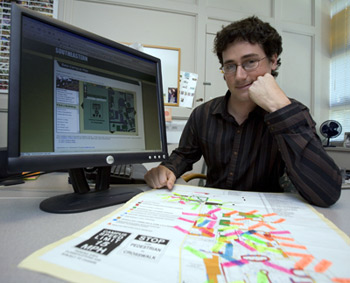Mapping a career path
On the home page
Click on the thumbnail for a larger picture.
Junior Visual Arts major Dakota Chichester of Hammond and Web Coordinator Amber Layton discuss the new interactive campus map that Chichester created for Southeastern’s Web site.
Dakota Chichester, Visual Arts major with Graphic Design concentration
Amber Layton, Web Coordinator
Gary Keown, Professor of Visual Arts
On the eve of her first day of class, a new freshman nervously wonders if she can
remember how to find White Hall.
A busy businessman is due at a luncheon at Twelve Oaks.
A couple is making plans to drive in from Slidell for a concert at the Pottle Music
Building Auditorium.
None of them will have to stop or call for directions, thanks to the hard work of visual arts student Dakota Chichester. The new interactive, high-tech map he created for Southeastern’s Web site will take them virtually by the hand and lead them right to their destination.
Linked on the home page, www.selu.edu, the map has everything they need to know about White Hall, Twelve Oaks, Pottle and any other Southeastern building. With just a couple of clicks, they can find out how to get there, what the building looks like, who to contact, and what it houses.
 |
|
| Dakota Chichester, Visual Arts major concentrating on graphic design. |
|
He hooked up with the Web redesign team when he responded to a student worker job advertised by Web Coordinator Amber Layton. Then in the first phases of a complete redesign of www.selu.edu, Layton welcomed him with open arms. Chichester has worked hand-in-hand with her on the myriad of design and web authoring tasks that have transformed the Web site into an attractive, up-to-date, user-friendly tool for marketing, recruiting, and generally serving the campus and the community.
“I am extremely fortunate that Dakota has the skill set that he does. It’s very hard to come across a designer who can also program,” said Layton.
“We sat down early on and talked about the projects we needed to include in the redesign,” she said. “One of the things on our list was the map, which is consistently in the top ten of web features that people search for. We looked at examples of other universities. We consulted with campus departments, such as the University Police Department and Admissions about the features they wanted,” Layton said. “Dakota took the job and ran with it.”
His campus job, partnered with his graphic design courses, “gives me the experience and the ability to add these kinds of projects to my portfolio,” Chichester said. “I have been doing web pages for years, but I’ve never done work this big. The map and the fact that I have been part of a web design for a huge ‘client’ like Southeastern is great to put in my portfolio for later in life.”
Chichester has also had the opportunity to use his graphic design skills on projects such as the university’s annual “Profile,” a fact book published annually by the Office of Institutional Research and Assessment. That kind of hands-on practical experience is a hallmark of Southeastern’s graphic design program. Students in graphic design classes are frequently tapped for designs by campus departments, even by community members.
Department of Visual Art graphic design professor Gary Keown said he welcomes the “interdisciplinary dialogue” the projects create with his colleagues across campus. His graphic design students have created a holiday card for the university president, a poster for a local fireworks company, and logos for entities such as the university’s annual arts festival Fanfare, KSLU radio station, and the Recreational Sports and Wellness Department.
“In addition to the on-campus training, we encourage the students to complete an internship so they get a feel for how design works in the real world,” Keown said. “And we help them ‘package’ themselves so that when they graduate, they are ready to go out into that real world as confident design professionals.”
More Homepage Stories...

